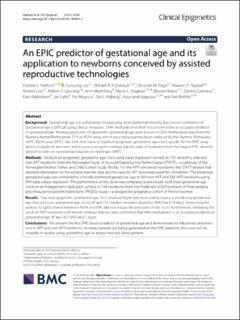| dc.contributor.author | Haftorn, Kristine Løkås | |
| dc.contributor.author | Lee, Yunsung | |
| dc.contributor.author | Denault, William Robert Paul | |
| dc.contributor.author | Page, Christian Magnus | |
| dc.contributor.author | Nustad, Haakon Egdetveit | |
| dc.contributor.author | Lyle, Robert | |
| dc.contributor.author | Gjessing, Håkon Kristian | |
| dc.contributor.author | Malmberg, Anni | |
| dc.contributor.author | Magnus, Maria Christine | |
| dc.contributor.author | Næss, Øyvind | |
| dc.contributor.author | Czamara, Darina | |
| dc.contributor.author | Räikkönen, Katri | |
| dc.contributor.author | Lahti, Jari | |
| dc.contributor.author | Magnus, Per Minor | |
| dc.contributor.author | Håberg, Siri Eldevik | |
| dc.contributor.author | Jugessur, Astanand | |
| dc.contributor.author | Bohlin, Jon | |
| dc.date.accessioned | 2021-09-03T11:09:00Z | |
| dc.date.available | 2021-09-03T11:09:00Z | |
| dc.date.created | 2021-09-02T10:39:43Z | |
| dc.date.issued | 2021 | |
| dc.identifier.issn | 1868-7075 | |
| dc.identifier.uri | https://hdl.handle.net/11250/2772842 | |
| dc.description.abstract | Background: Gestational age is a useful proxy for assessing developmental maturity, but correct estimation of gestational age is difficult using clinical measures. DNA methylation at birth has proven to be an accurate predictor of gestational age. Previous predictors of epigenetic gestational age were based on DNA methylation data from the Illumina HumanMethylation 27 K or 450 K array, which have subsequently been replaced by the Illumina MethylationEPIC 850 K array (EPIC). Our aims here were to build an epigenetic gestational age clock specific for the EPIC array and to evaluate its precision and accuracy using the embryo transfer date of newborns from the largest EPIC-derived dataset to date on assisted reproductive technologies (ART).
Methods: We built an epigenetic gestational age clock using Lasso regression trained on 755 randomly selected non-ART newborns from the Norwegian Study of Assisted Reproductive Technologies (START)—a substudy of the Norwegian Mother, Father, and Child Cohort Study (MoBa). For the ART-conceived newborns, the START dataset had detailed information on the embryo transfer date and the specific ART procedure used for conception. The predicted gestational age was compared to clinically estimated gestational age in 200 non-ART and 838 ART newborns using MM-type robust regression. The performance of the clock was compared to previously published gestational age clocks in an independent replication sample of 148 newborns from the Prediction and Prevention of Preeclampsia and Intrauterine Growth Restrictions (PREDO) study—a prospective pregnancy cohort of Finnish women.
Results: Our new epigenetic gestational age clock showed higher precision and accuracy in predicting gestational age than previous gestational age clocks (R2 = 0.724, median absolute deviation (MAD) = 3.14 days). Restricting the analysis to CpGs shared between 450 K and EPIC did not reduce the precision of the clock. Furthermore, validating the clock on ART newborns with known embryo transfer date confirmed that DNA methylation is an accurate predictor of gestational age (R2 = 0.767, MAD = 3.7 days).
Conclusions: We present the first EPIC-based predictor of gestational age and demonstrate its robustness and precision in ART and non-ART newborns. As more datasets are being generated on the EPIC platform, this clock will be valuable in studies using gestational age to assess neonatal development. | en_US |
| dc.language.iso | eng | en_US |
| dc.publisher | BioMed Central | en_US |
| dc.rights | Navngivelse 4.0 Internasjonal | * |
| dc.rights.uri | http://creativecommons.org/licenses/by/4.0/deed.no | * |
| dc.title | An EPIC predictor of gestational age and its application to newborns conceived by assisted reproductive technologies | en_US |
| dc.type | Journal article | en_US |
| dc.type | Peer reviewed | en_US |
| dc.description.version | publishedVersion | en_US |
| dc.rights.holder | Copyright the authors 2021 | en_US |
| dc.source.articlenumber | 82 | en_US |
| cristin.ispublished | true | |
| cristin.fulltext | original | |
| cristin.qualitycode | 1 | |
| dc.identifier.doi | 10.1186/s13148-021-01055-z. | |
| dc.identifier.cristin | 1930710 | |
| dc.source.journal | Clinical Epigenetics | en_US |
| dc.identifier.citation | Clinical Epigenetics. 2021, 13, 82. | en_US |
| dc.source.volume | 13 | en_US |

